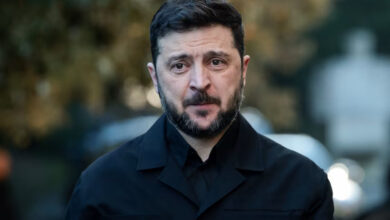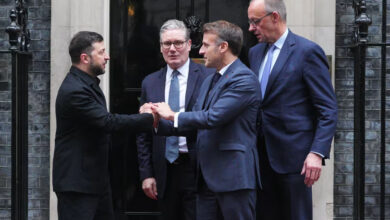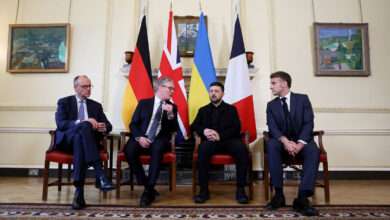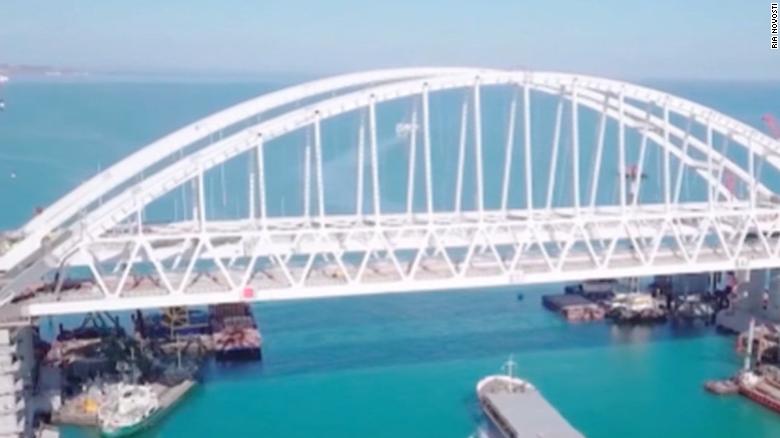
It brings forward by a number of weeks the strategic choices he must make about Russia’s occupation of southern Ukraine. This entire presence was already poorly supplied, managed and in retreat. And it shows that the key railway route into Crimea and onwards to the frontlines in Kherson is highly vulnerable to future attacks.
While Kyiv has not claimed responsibility for the Kerch Strait bridge blast, it has previously taken credit for a series of strikes on targets in Russian-occupied Crimea over the summer.
Russian officials said a limited amount of car traffic had resumed on undamaged sections of the bridge’s roadways by Saturday evening and that train services were resuming on the bridge’s railways. But trucks were being asked to take ferries across the strait, state media reported.
Rickety ferry crossings in bad weather or highly dangerous air cargo flights may now be needed to bolster military shipments into Crimea and towards the frontlines, which will place more pressure on a single railway track further east coming through Melitopol along the Azov Sea coast.
It exposes the staggering 20th century weakness of Russia’s armed forces and occupation: They need railways to get around.
Ukraine has been targeting this system with slow, patient accuracy. First Izium, which led to the collapse around Kharkiv. Then Lyman, which is leading to the erosion of Russia’s control of Donetsk and Luhansk. And now the Kerch Bridge, which had become so vital to everything that Russia is trying to hold on to in the south.
Compounding the problem for Putin is the fact that Russia’s rail hub further inside Donetsk was also hit on Saturday; a look at Ilovaisk on a map shows the railway arteries running through it. A cargo train detonated there this morning, likely having some impact on Russia’s ability to feed the railway lines inside Donetsk and Luhansk that Ukraine has already put under great pressure.
Ukraine has had patient timing on hitting these pressure points. They have not struck until they have seen a moment of weakness – until the Russians are experiencing serious issues already – ensuring that the damage inflicted lasts while time-consuming repairs are underway. (While Russia claims that railway traffic was set to be restored by Saturday night, the bridge’s vulnerability to attack at the least will lessen traffic).
A challenge to Putin’s poker face
Putin now faces a series of expedited and painful decisions, all of which will severely belie his continued poker-face of pride and bombast towards the gathering signs of slow defeat. To the west of the Dnipro river, his army in Kherson is besieged by fast-moving Ukrainian forces. They are already in retreat, partially owing to the same poor resupply that will be accentuated by the Kerch blast.
They are again cut off from this faltering supply line by another series of damaged or targeted bridges across the Dnipro. Over the past week, they have already fallen back over 500 square kilometers. Can Moscow sustain this force over two damaged supply routes? A precarious presence has perhaps overnight become near-impossible. Does enough truth filter through to the Kremlin head to lead him to pull back? Or does he take the higher stakes gamble of spreading his isolated forces thinly across a wide expanse?
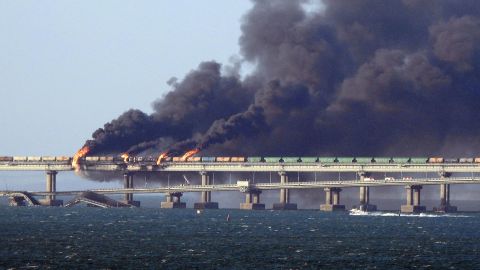
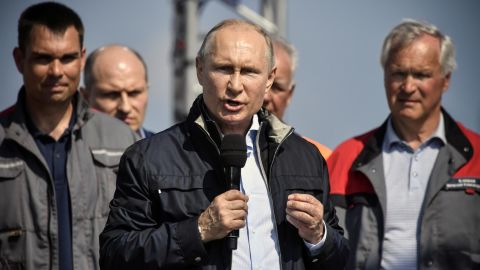
The second point of decision relates to Crimea. Putin personally opened the bridge across the Kerch Strait by driving a truck across it in 2018. The illegal annexation of the Ukrainian territory has been the source of misplaced pride and imperial pomp for the Kremlin. But Putin now faces the difficult choice of fortifying it further with depleted forces who face resupply issues, or partially withdrawing his military to ensure their significant resources on the peninsula do not get cut off.
There is a sizeable risk of this. The Kerch bridge can be hit again. The railway link across Melitopol is now a target of outsized value. Ukrainian President Volodymyr Zelensky said just last week that an offensive from Zaporizhzhia towards Melitopol was a possibility. The mere possibility that Russia’s last untouched railway path into the south could be disrupted raises existential issues for its occupation.
Putin must choose between feeding his larger ambitions with a dwindling chance of success, or consolidating forces around an objective he has a greater chance of achieving. One carries the risk of catastrophic collapse, for his entire brutal adventure into Ukraine, and quite possibly his rule. The second leaves him with an immediate loss of face, but a stronger chance of sustaining the occupation of smaller parts of Ukraine.
His internal position has not looked weaker since he came to power in 2000. An admission of failure may be unpalatable at this stage, and a greater gamble the easier move. Yet he again tips the war towards a binary moment where his occupation – and even regime – faces a complete collapse or a tiny, madcap prospect of victory. Nuclear threats and rhetoric have been the horrifying backdrop of this war. Yet still Moscow has not resorted to any doomsday moves while NATO armed Ukraine to an extent that was unthinkable before the war.
Kyiv’s smart and patient strikes on Russia’s ageing transport dependencies has left Putin with a series of existential decisions to make in the hours ahead. He’s made a lot of bad ones in the past seven months. Does the Kerch explosion add to that list, or provide a cold bath of reality, and a readjustment of the Kremlin’s view of the possible.

